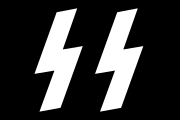Erwin Schulz
| Erwin Schulz | |
|---|---|
|
Erwin Schulz at the Einsatzgruppen Trial | |
| Born |
27 November 1900 Berlin, German Empire |
| Died |
11 November 1981 (aged 80) Place unknown |
| Allegiance |
|
| Service/branch |
Security Service (Sicherheitsdienst or SD) |
| Years of service | 1935–1945 |
| Rank | brigadier general (Brigadeführer) |
| Unit | Einsatzgruppe C |
| Commands held | Death squad 5 (Einsatzkommando 5) |
Erwin Schulz (27 November 1900 in Berlin – 11 November 1981) was a German member of the Gestapo and the SS in Nazi Germany. He was the leader of Death squad 5 (Einsatzkommando 5), part of Einsatzgruppe C, which was attached to the Army Group South during the planned invasion of Soviet Union in 1941, and operated in the occupied territories of south-eastern Poland and Ukrainian SSR committing mass killings of civilian population, mostly of Jewish ethnicity, under the command of SS-brigadier general Otto Rasch.[1]
Career
Schulz never received a doctorate in law although some Nazis called him Dr. Schulz. He studied law only for two semesters in Berlin but left university to join the Freikorps in 1922.[1] For a time, he worked in a bank and relocated to Hamburg in 1923. He joined the uniformed police force (Schutzpolizei) in Bremen,[1] and in 1926 was appointed a police lieutenant. In 1931 he was an informant for the SS. He officially joined the Nazi Party in May 1933 and in November was appointed head of the Gestapo of Bremen. In 1935 he joined the SS and SD. In March 1938 he was promoted to SS-Major (Sturmbannführer) and State Councillor for the state of Bremen. In April 1940 he was inspector-instructor of cadets of the SiPo and SD at Charlottenburg.
In May 1941 Schulz was appointed chief of Death squad 5. He directed the execution of thousands of Jews in Lvov, Zhytomyr, Dubno and Berdychiv between June and late August 1941. When he convened with Otto Rasch at Zhytomyr in mid August 1941, Rasch informed him that on the orders of Adolf Hitler, more Jews needed to be shot. The Senior SS and police leader for occupied Eastern Russia Friedrich Jeckeln ordered that all Jews not engaged in forced labor, including women and children, were to be slaughtered.[2] Schulz summarized the meeting:
After about two weeks' stay in Berdichev the commando leaders were ordered to report to Zhitomir, where the staff of Dr. Rasch was quartered. Here Dr. Rasch informed us that Obergruppenführer Jeckeln had been there, and had reported that the Reichsführer-SS had ordered us to take strict measures against the Jews. It had been determined without doubt that the Russian side had ordered to have the SS members and Party members shot. As such measures were being taken on the Russian side, they would also have to be taken on our side. All suspected Jews were, therefore, to be shot. Consideration was to be given only when they were indispensable as workers. Women and children were to be shot also in order not to have any avengers remain. We were horrified, and raised objections, but they were met with a remark that an order which was given had to be obeyed.[3]
Shortly thereafter he questioned both Bruno Streckenbach and Reinhard Heydrich on this point; it was confirmed that this order had come from Hitler. Schulz asked to be relieved of his post, citing that he was not made for this kind of mission in the East.[4] At the end of August, he left Zhytomyr for Berlin and was promoted to SS-Oberführer. He was appointed deputy to Erwin Rösener, SS and Police Leader and commander of SS-Oberabschnitt Alpenland from 1 May to 28 May 1944.
Arrested by the Allies, Schulz wrote a letter to Lucius D. Clay, deputy to General Dwight D. Eisenhower, requesting clemency.[2]
At the Einsatzgruppen Trial, the Tribunal acknowledged that he had acted to oppose the "intolerable" situation that was put to him but found him guilty of committing mass murder and sentenced him to 20 years in prison. This sentence was commuted to 15 years in prison in January 1951. On 9 January 1954 Schulz was released from the prison for war criminals in Landsberg on probation.[5]
References
- 1 2 3 N.M.T. (1945). "Trials of War Criminals before the Nuernberg Military Tribunals" (PDF direct download). Volume IV : "The Einsatzgruppen Case" complete, 1210 pages. Nuremberg Military Tribunals under Control Council Law No. 10. pp. 542–543 in PDF (518–519 in original document). Retrieved 1 March 2015.
With N.M.T. commentary to testimony of Erwin Schulz (pp. 165–167 in PDF).
- 1 2 Browning, Christopher (2004). The Origins of the Final Solution: The Evolution of Nazi Jewish Policy, September 1939 – March 1942. With contributions by Jürgen Matthäus. Lincoln: University of Nebraska Press. p. 663. ISBN 0-803-25979-4.
- ↑ Richard Rhodes (2002). Masters of Death: The SS-Einsatzgruppen and the Invention of the Holocaust. New York City: Alfred A. Knopf. pp. 124–5. ISBN 0-375-40900-9.
- ↑ Peter Longerich (2010). Holocaust: The Nazi Persecution and Murder of the Jews. Oxford University Press. p. 225. ISBN 978-0-19-280436-5.
- ↑ This article incorporates information from the corresponding article in the French Wikipedia
